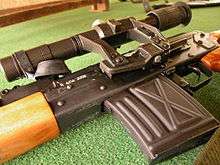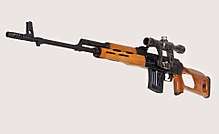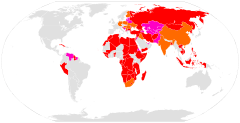PSL (rifle)
The PSL (Romanian: Puşcă Semiautomată cu Lunetă model 1974, "scoped semi-automatic rifle") is a Romanian military designated marksman rifle. It is also called PSL-54C, Romak III, FPK and SSG-97 (Scharfschützengewehr 1997).[4] Though similar in appearance to the SVD Dragunov, the PSL rifle is mechanically completely different and based on the RPK light machine gun.[5]
| PSL | |
|---|---|
 The PSL | |
| Type | Designated marksman rifle |
| Place of origin | Romania |
| Service history | |
| In service | 1974–present |
| Used by | See Users |
| Wars | Romanian Revolution Lebanese Civil War Gulf War[1] War in Afghanistan Iraq War[2] Libyan Civil War Syrian Civil War Libyan Civil War (2014–present) War in Donbass Iraqi Civil War (2014–2017) Yemeni Civil War (2015–present) Saudi-led intervention in Yemen Conflict in Najran, Jizan and Asir[3] |
| Production history | |
| Designed | 1974 |
| Manufacturer | Fabrica de Arme Cugir SA (ROMARM consortium) |
| Produced | 1974–present |
| Specifications | |
| Mass | 4.31 kg (9.5 lb) (empty with scope) |
| Length | 1,150 mm (45.3 in) |
| Barrel length | 620 mm (24.4 in) |
| Cartridge | 7.62×54mmR 7.62×51mm NATO |
| Caliber | 7.62 mm |
| Action | Gas-operated, long stroke; semi-automatic |
| Rate of fire | 30 rpm |
| Muzzle velocity | 830 m/s (2,723.1 ft/s) with 10 grams (154 gr) projectile (7N14) |
| Effective firing range | 800–1,000 m |
| Maximum firing range | ~3000 metres |
| Feed system | 10 round detachable box magazine, 5 round detachable box magazine (no longer produced) |
| Sights | LPS-4 scope with tritium illuminated reticle + iron tangent sights |
History
The project to develop the PSL commenced after the Soviet Union ceased sharing technical information and exporting military equipment (including the SVD Dragunov) to Romania, as a consequence of the latter's refusal to join the Invasion of Czechoslovakia.
PSL rifles were originally made at the Regia Autonomă pentru Producţia de Tehnică Militară – RATMIL Cugir arsenal in Cugir, Romania. After a consolidation of military arsenals when Romania joined NATO, production of the PSL is now at the SC Fabrica de Arme Cugir SA (ARMS arsenal) in Cugir, Romania which is completely retooled with all brand new state-of-the-art equipment.
The PSL rifle's primary purpose is to be used by a platoon level designated marksman to engage targets at ranges beyond the capabilities of the standard issue AKM assault rifles. It is built around a stamped steel receiver similar to that of the RPK light machine gun; having a wider forward section enabling a strengthened, more substantial front trunnion. The PSL's operation is the same long stroke piston action of the Kalashnikov family of weapons. Its appearance is similar to the Dragunov sniper rifle yet not one single part interchanges between the rifles.
Design
The PSL is chambered for the same venerable 7.62×54mmR (rimmed) cartridge as the Dragunov, and feeds from a ten-round detachable box magazine. The magazine used on the PSL differs from that of Dragunov models in that it is stamped with an X shaped pattern on the side, rather than the waffle style stamp found on the Russian and Chinese magazines. The magazines, though they are similar in shape and size, are not interchangeable between the Dragunov and PSL without modification.
The PSL has been in service in Romania since the 1970s and is widely sold on the world market. They are frequently encountered in Iraq where they appear to be quite popular. The simplicity of the rifle makes it ideal for soldiers to use and maintain. The action, being a variant of the AKM's, is extremely reliable despite lack of maintenance, and is particularly forgiving of sand and other debris. The scope's reticle pattern is easy to use and makes range estimation quick and reasonably accurate without any mathematical calculations necessary. With some simple instruction an average individual can be issued a PSL and successfully engage targets at ranges that far exceed the accurate capabilities of non-scoped assault rifles like the AKM, AK-47, etc. Accuracy varies greatly, however, between individual rifles to a greater extent to other rifles in its class, probably due to insufficient quality control during the manufacturing process. In the hands of a capable shooter and with quality ammunition such as 7N1 and 7N14 a PSL is capable of 1 Minute of angle (approximately 1" at 100 yards) or less while the rifles on the other end of the spectrum are only capable of about 3 MOA. The PSL has, however, gained notoriety due to bolt carriers cracking when used with heavy ball (147 grain or greater) ammo and silencers, in part thanks to the lack of adjustable gas. Aftermarket gas system upgrades (both PSL dedicated and retrofitted standard AK) have been known to solve the problem. Another, more risky, solution is to drill out the gas transfer port and fit a vented screw (which has a narrower vent diameter than the starting port size) inside.[6][7]
PSL rifles have some notable features, the skeleton stock is somewhat similar to the Dragunov's but includes an interesting corrugated and spring-loaded stamped steel buttplate. When the rifle is fired this helps reduce the felt recoil to a degree. The cheek riser on the comb of the stock is angled to benefit the right-handed shooter primarily. Some owners feel the cheek pad is not high enough to adequately attain a rigid cheek weld and have to make do with a chin weld.
The butt stock is much shorter than most Western shooters are used to. This is because Romanian soldiers active during the Winter often operate in very cold climates and wear thick winter coats while on duty. In theory, a rubber stock extender is to be fitted during the hot Romanian summer, but one is not issued with the rifle.
LPS 4×6° TIP2 telescopic sight
The PSL's telescopic sight is made by the Romanian Optical Enterprise (IOR) in Bucharest. IOR is a Romanian company which has been making optics since 1936. They currently use German made Schott glass coated with the Carl Zeiss T-3 system to eliminate glare and maximize light transmission. It is unknown what glass and coatings they used at the time they produced the PSL's scope, however IOR had a long association with western European optics manufacturers and maintained these despite being caught within the Iron Curtain. In 1967 IOR collaborated with various German manufacturers and in 1975 an association was established with Carl Zeiss which led to even more expansion and modernization.
The PSL was originally issued with the type 1 version of the LPS telescopic sight. This 4×24 scope was more or less identical to the Russian PSO-1 telescopic sight with a battery-powered reticle illumination and an IR detection filter. These scopes stopped being produced around 1974 and are rather rare today with collectors paying a premium for them. Shortly afterward the LPS scope was technically revised to simplify the maintenance and construction of the scope.
The PSL rifle is typically issued with a 4×24 optical sight called LPS 4×6° TIP2 (Lunetă Puṣcă Semiautomată Tip 2, or "Scope, Semi-Automatic Rifle, Type #2") which is a simplified version of the Russian PSO-1 telescopic weapon sight. This optical sight features 4× magnification, a 6° field of view, and the objective lens is 24 mm in diameter. It shares the basic design and stadiametric rangefinder found in the reticle of the original Russian PSO-1 scope. The LPS 4×6° TIP2 elevation turret features bullet drop compensation (BDC) in 50 m increments for engaging point and area targets at ranges from 100 m up to 1,000 m. The BDC feature must be tuned at the factory for the particular ballistic trajectory of a particular combination of rifle and cartridge at a predefined air density. Inevitable BDC induced errors will occur if the environmental and meteorological circumstances deviate from the circumstances the BDC was calibrated for. Marksmen can be trained to compensate for these errors. Besides the BDC elevation or vertical adjustment control of the reticle, the windage or horizontal adjustment control of the reticle can also be easily dialed in by the user without having to remove turret caps etc. The reticle illumination of the LPS 4×6° TIP2 is provided by (radioactive) tritium. The tritium light source has to be replaced every 8–12 years, since it gradually loses its brightness due to radioactive decay.[8]
The LPS 4×6° TIP2 is issued with a lens hood that can be attached to the ocular to reduce/eliminate image quality impairing stray light and a covers to protect the objective external lens surface against foul weather and damage.
Mounting system

The LPS telescopic sight propriety mount is adjustable for tension on the LPS rifle's side rail. This side rail is a Warsaw Pact rail similar in design to the mounting used for Russian SVD rifles and PSO-1 optical sights and positions the telescopic sight axis to the left side in relation to the receiver and bore center axis. The Warsaw Pact mount has a castle nut that screws into the bottom of the locking lever. The spring-loaded portion of the clamp has to be pressed down to tighten or loosen the castle nut as needed.
The scope can be easily removed from the receiver of the rifle by swinging the locking lever open, then sliding the scope mount to the rear. This allows easy access to the receiver cover which needs to be removed for cleaning.
Due to the offset to the left and the relative height of the mounting, the PSL iron sights can be used with a LPS scope mounted, though the positioning of the scope’s optical center axis may not be comfortable to all shooters.
Users


















Sporting version
A sporting version of the PSL, intended for export, is offered as the PSL-54C, Romak III, FPK, FPK Dragunov or SSG-97. This weapon is identical in almost every respect to the original military version of the PSL except for modifications to comply with the U.S. import laws regarding sporting rifles. These modifications include removal of the bayonet lug as well as the replacement of the original military receiver, which has three trigger mechanism axis pin holes instead of two. The third hole is for a safety sear that is thought to allow the rifle to be capable of being converted to "full-auto" by the end-user. US import versions are manufactured with a BATFE approved semi-auto Romanian receiver. The so-called "third hole" is not present, thus the trigger mechanism is simplified and omits the "full auto" safety sear. The military spec FPK is not capable of fully automatic fire however it includes this safety sear to ensure the rifle's hammer cannot be released before the bolt is fully forward and locked in place in the forward trunnion. Because of this fact, and the lack of a spring-loaded firing pin, there is some theoretical potential that the US legal PSL could fire out of battery (before the bolt is fully locked). The US commercial-spec rifles also sometimes omit the bolt hold-open mechanism that is on the true military spec rifles.
All sporting versions of the PSL are constructed using original Romanian parts and assembled either in Romania or in the United States, some using American made receivers. Examples of the commercial sporting version were also available (on a very limited production run) in the 7.62×51mm NATO (.308 Winchester) cartridge as opposed to the 7.62×54mmR mm these rifles are typically chambered for. A PSL with a 16" barrel was also marketed as the FPK Paratrooper, but no such rifle exists within the Romanian military, being purely a US made variant. These rifles were primarily imported by Century Arms International, InterOrdnance, and Tennessee Gun Importers (TG Knox).
Gallery
- PSL detail.
 PSL rifle scope detail.
PSL rifle scope detail.- Muzzle brake.
- Rear sight.
- LPS 4×6° TIP2 telescopic sight serial number.
- Windage turret markings.
- Elevation turret markings
 Ethiopian soldier fires a PSL sniper rifle at a shooting range outside Camp Ramrod, Ethiopia.
Ethiopian soldier fires a PSL sniper rifle at a shooting range outside Camp Ramrod, Ethiopia. PSL sniper rifle.
PSL sniper rifle. PSL sniper rifle
PSL sniper rifle
References
- "PSL rifle". iwm.org.uk. Imperial War Museum. Archived from the original on 2019-02-20. Retrieved 2019-02-20.
- Neville, Leigh (25 Aug 2016). Modern Snipers. General Military. Osprey Publishing. p. 153. ISBN 9781472815347.
- "YouTube". www.youtube.com.
- Vorobiev, Marco (2016-06-15). Gun Digest Shooter's Guide to AKs. "F+W Media, Inc.". ISBN 978-1-4402-4641-8. Archived from the original on 2018-02-05. Retrieved 2018-02-05.
- Kalashnikov AK-47 Assault Rifle, p. 39
- "Gas block restrictor jet to shoot Heavy ball". Archived from the original on 2019-03-07. Retrieved 2019-03-07.
- Romanian PSL SUPPRESSED!
- LPS scope at dragunov.net Archived 2012-06-05 at the Wayback Machine
- MilitaryFactory.com. "A Afghan soldier trains with his PSL Rifle". MilitaryFactory.com. Archived from the original on 2017-10-19. Retrieved 2017-06-22.
- "Designated Marksman dot net - Romanian PSL rifles in action". www.designatedmarksman.net. Retrieved 13 July 2020.
- Report of the Monitoring Group on Somalia and Eritrea pursuant to Security Council resolution 2317 (2016): Eritrea (PDF) (Report). 6 November 2017. pp. 18, 52–53. S/2017/925. Archived (PDF) from the original on 2 September 2018. Retrieved 2 September 2018.
- Miranda, Miguel (14 June 2018). "Africa's Forgotten War". History of War. Archived from the original on 28 June 2018. Retrieved 28 June 2018.
- Rottman, Gordon L. (1993). Armies of the Gulf War. Elite 45. Osprey Publishing. p. 49. ISBN 9781855322776.
- "Designated Marksman dot net - Romanian PSL rifles in action". www.designatedmarksman.net. Archived from the original on 2018-06-28. Retrieved 2018-06-28.
- https://sun9-24.userapi.com/c626220/v626220335/1bab0/vCWExnVsuyQ.jpg. Retrieved 4 July 2020. Missing or empty
|title=(help) - https://sun9-42.userapi.com/c624822/v624822335/40d63/O1N_CWhKIkk.jpg. Retrieved 4 July 2020. Missing or empty
|title=(help) - Army Recognition (2009-11-05). "Somalia Ranks and combat uniforms Somali Army". armyrecognition.com. Archived from the original on 2017-07-05. Retrieved 2017-06-22.
Bibliography
- Ezell, E (1983) Harrisburg, PA: Stackpole Books, p. 637. ISBN 0-88029-601-1
- Günter Wollert; Reiner Lidschun; Wilfried Kopenhagen, Illustrierte Enzyklopädie der Schützenwaffen aus aller Welt : Schützenwaffen heute (1945–1985), Berlin : Militärverlag der Deutschen Demokratischen Republik, 1988. OCLC 19630248
- Rottman, Gordon; Shumate, Johnny: Kalashnikov AK-47 Assault Rifle, Osprey Publishing, 2011, ISBN 978-1-84908-461-1
External Links
| Wikimedia Commons has media related to PSL rifle. |
